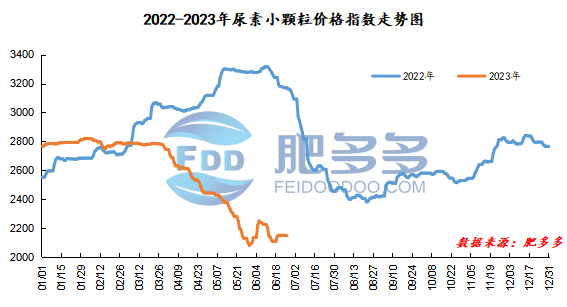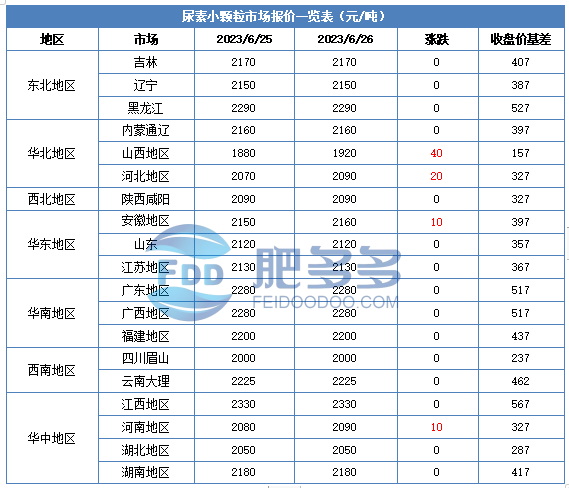- Mall
- Supermarket
- Supplier
- Cross-Border Barter
- Industrial Data
- Warehouse Logistics
- Trade Assurance
- Expo Services
China Urea Price Index:
According to Feiduo data, the urea small pellet price index on June 26 was 2,150.23, up 3.64 from yesterday, up 0.17% month-on-month, and down 32.19% year-on-year.

Urea futures market:
The price of the urea UR2309 contract continued to fluctuate after the opening of early trading today. In the afternoon, the futures price fluctuated and then rose to close, closing at 1763 at the end. The opening price of the Urea UR2309 contract: 1708, the highest price: 1765, the lowest price: 1705, the settlement price: 1734, the closing price: 1763. The closing price increased by 61, or 3.58% compared with the settlement price of the previous trading day. The daily fluctuation range is 1705-1765, and the spread is 60; The 09 contract has reduced its position by 4110 lots today, and has held 414605 lots so far.
Spot market analysis:
Today, the price of cattle in China's spot market rose sporadically, with the range concentrated at 10-40 yuan/ton. Due to the emergence of regional agricultural demand, factories saw the trend and raised prices and accepted orders. However, industrial demand is still weak, and the current urea spot market is performing strongly. Specifically, prices in Northeast China have stabilized at 2,110 - 2,300 yuan/ton. Prices in North China rose to 1,920 - 2,160 yuan/ton. Prices in the northwest region are stable at 2,090 - 2,100 yuan/ton. Prices in Southwest China have stabilized to 2,000 - 2,250 yuan/ton. Prices in East China rose to 2,080 - 2,180 yuan/ton. The price of small and medium-sized particles in Central China has stabilized at 2,050 - 2,350 yuan/ton, and the price of large particles has stabilized at 2,100 - 2,120 yuan/ton. Prices in South China are stable at 2,200 - 2,280 yuan/ton.
Market outlook forecast:
In terms of futures, today's futures prices stabilized first and then rose, actively driving the upward adjustment of spot market prices. Fundamentally speaking, the daily output on the supply side is still around 170,000 tons, and the supply is always sufficient. Due to the instability of the spot market during this period, grassroots agricultural supplies companies no longer have large inventories, so there is not much pressure on market inventories, and the downstream is in a state of active digestion. Once there is demand, they will collect goods in a short period of time. However, with the end of this wave of fertilization and topdressing, concentrated demand gradually disappeared, and most of them were mainly in need of procurement. Recently, some areas have been affected by high stability, and urea plant failures have increased. However, due to weakening agricultural demand, market supply and demand are relatively balanced. Overall, the short-term spot market may remain volatile. But in the long run, agricultural demand may still partially appear after July. Markets may fluctuate repeatedly as demand changes.
